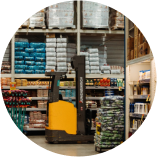What is Order Management Software?
Key Takeaways:
What is Order Management Software?
Important Features in Order Management
How Does the Order Management Process Work?
How to Choose the Best Order Management System?
Best Order Management Software Options
Difference Between CRM and Order Management
Is Order Management Part of the Supply Chain?
Conclusion

Content
What is Order Management Software?
Shujaat Khan
2024-08-07
Key Takeaways:
- OMS streamlines order processing, reducing errors and providing real-time inventory insights.
- Key features include inventory management, order tracking, automated shipping, and multi-channel support.
- Top OMS options: Asaan Retail, Zoho Inventory, Shippo, and QuickBooks Commerce.
- Enhances efficiency and customer satisfaction with comprehensive tools.
----------------------------------------------------------------------------------
In the fast-paced world of e-commerce and retail, efficient order management can make or break a business. With the rising expectations of consumers for quick and accurate deliveries, businesses need robust systems to handle their orders from start to finish.
This is where Order Management Software (OMS) comes into play. But what exactly is OMS, and why is it essential for modern businesses?
What is Order Management Software?
Order Management Software is a digital tool that helps businesses track sales, orders, inventory, and fulfillment. It automates and streamlines the order processing cycle, ensuring that every step, from order placement to delivery, is managed efficiently.
Importance in Modern Business
In today's competitive market, customer satisfaction is paramount. On one hand OMS helps businesses meet customer expectations by ensuring that orders are processed accurately and delivered on time. On the other hand, it keeps customers updated about their order status.
Crucially, an OMS minimizes errors, reduces manual work, and provides real-time insights into inventory levels and order status.
What Does an Order Management System Do?
Streamlining Operations
OMS simplifies and automates various tasks, including order entry, inventory management, and shipping by integrating with multiple sales channels to capture orders automatically, updating inventory levels in real-time to prevent stockouts, and generating shipping labels and schedules automatically.
Enhancing Customer Experience
A well-implemented OMS improves customer experience by providing accurate information about order status through real-time tracking updates, ensuring timely delivery by automating shipping schedules, and facilitating easy returns and exchanges with automated return processing. This streamlined approach enhances overall customer satisfaction.
Important Features in Order Management
Inventory Management
An essential feature of OMS is inventory management. It keeps track of stock levels in real-time, preventing stockouts and overstock situations.
Order Tracking
OMS allows businesses and customers to track orders from placement to delivery. This transparency builds trust and ensures that customers are informed every step of the way.
Automated Shipping
Automated shipping features streamline the fulfillment process by generating shipping labels, calculating shipping costs, and scheduling pickups with carriers.
Multi-Channel Support
With multi-channel support, OMS can integrate with various sales channels, including online stores, marketplaces, and physical retail locations, ensuring seamless order processing across all platforms.
How Does the Order Management Process Work?
Order Placement
The process begins when a customer places an order through a sales channel, such as an e-commerce website or a physical store.
The OMS captures all relevant order details, including product information, customer data, and payment method.
It then automatically updates the inventory to reflect the new order, ensuring accurate stock levels and preventing overselling.
Order Processing
Once the order is placed, the OMS processes it by verifying the payment details to ensure the transaction is complete and legitimate.
It checks stock availability in real-time to confirm that the items are in stock and ready for shipment. The system then prepares the order for fulfillment, which includes generating a pick list and packing slip.
Order Fulfillment
In the fulfillment stage, the OMS coordinates the picking, packing, and shipping of the order. Warehouse staff use the pick list to gather the items, which are then packed securely for shipment.
The OMS generates shipping labels and schedules pickups with carriers. It also updates the order status and sends tracking information to the customer, keeping them informed about the delivery progress.
Post-Sales Support
After delivery, the OMS manages any post-sales activities, including processing returns, exchanges, and handling customer support inquiries.
The system automates the return process by generating return labels and updating inventory levels once returned items are received. It also tracks customer interactions, ensuring a smooth and satisfactory post-sales experience.
How to Choose the Best Order Management System?
Assessing Business Needs
The first step in choosing an OMS is to assess your business needs. Consider the size of your business, the volume of orders, and the complexity of your operations.
Scalability
Choose an OMS that can scale with your business. As your business grows, your OMS should be able to handle increased order volumes and additional sales channels.
Integration Capabilities
Ensure that the OMS can integrate with your existing systems, including your e-commerce platform, CRM, and accounting software. This integration is crucial for seamless operations.
Cost Considerations
Consider the cost of the OMS, including initial setup, subscription fees, and any additional costs for features or integrations. Choose a system that fits your budget while meeting your needs.
Best Order Management Software Options
From the list of best order management softwares, some of the top OMS options include:From the list of best order management softwares, some of the top OMS options include:
- Asaan Retail: Offers a complete suite of management tools and robust features for managing orders, inventory, and fulfillment. Known for real-time inventory updates and advanced reporting. Pick, Pack & Ship functionality allows seamless order fulfillment process. Pricing starts at $30/month.
- Zoho Inventory: Offers comprehensive features including shipment tracking and multi-warehouse management. Suitable for small to growing businesses.
- Shippo: Focuses on simplifying shipping for businesses of all sizes with integrations to major e-commerce platforms and discounted shipping rates. Pricing starts at $19/month plus usage fees, with a free plan available.
- QuickBooks Commerce: Combines inventory and order management with financial, payment, reporting, and accounting tools of QuickBooks. Ideal for businesses looking to integrate financial and inventory management. QuickBooks Online plans start at $30/month.
Each of these systems offers features and integrations to help streamline your order management process. Compare the features, pricing, and user reviews of different OMS options to find the one that best suits your business needs.
Difference Between CRM and Order Management
Primary Functions
Although usually considered the same, a Customer Relationship Management (CRM) system focuses on managing customer interactions and data, such as tracking inquiries, managing marketing campaigns, and analyzing customer feedback to improve relationships and drive sales.
Order Management Systems (OMS), on the other hand, are centered on processing and fulfilling orders, handling tasks like capturing order details, managing inventory, processing payments, and coordinating shipping. The main goal of an OMS is to ensure accurate and timely order processing and delivery.
Overlap and Integration
There is often overlap between CRM and OMS, and many businesses benefit from integrating the two. This integration allows for better customer insights by combining data from both systems. For example, a CRM can provide purchase history and preferences, while an OMS offers real-time order status and inventory levels.
This combined data helps businesses tailor marketing efforts, improve customer service, and make informed decisions.Integration also enhances order processing efficiency by reducing manual data entry and minimizing errors, allowing customer service representatives to access order information quickly and accurately.
Is Order Management Part of the Supply Chain?
Role in Supply Chain Management
Order management is a critical component of the supply chain, connecting various activities from inventory management to shipping and delivery. It captures order details and updates inventory levels to ensure accurate stock information, which is crucial for effective planning.
It coordinates order processing, including payment verification and stock checks, to ensure only valid orders proceed. This reduces delays and errors in the supply chain.
During fulfillment, order management oversees picking, packing, and shipping, generating shipping labels, scheduling carrier pickups, and providing tracking information. Efficient management of these activities ensures timely deliveries and enhances overall supply chain reliability.
An efficient OMS reduces errors, improves order accuracy, and speeds up the fulfillment process, thereby boosting supply chain efficiency.
Conclusion
Order Management Software is an indispensable tool for modern businesses. It streamlines operations, enhances customer satisfaction, and integrates seamlessly with other business systems. By choosing the right OMS, businesses can improve efficiency, reduce costs, and stay competitive in today's fast-paced market. Don't wait to transform your business operations—explore Asaan Retail's OMS solutions today and take your business to the next level!
Related Articles

Woocommerce
Setting up a WooCommerce E Commerce Store
Shujaat Khan
2024-04-03

Point of Sales
Essential Hardware You Need For a POS Software
Shujaat Khan
2024-04-05

Point of Sales
What is a Retail Point of Sale System?
Shujaat Khan
2024-04-06

Point of Sales
Simplifying IT with the Right Retail POS
Shujaat Khan
2024-04-06
Start 14 days free trial or book a demo with us


